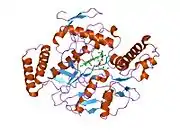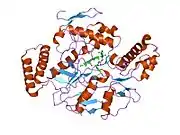NOS1
Nitric oxide synthase 1 (neuronal), also known as NOS1, is an enzyme that in humans is encoded by the NOS1 gene.[5][6]
Function
Nitric oxide synthases (EC 1.14.13.39) (NOSs) are a family of synthases that catalyze the production of nitric oxide (NO) from L-arginine. NO is a chemical messenger with diverse functions throughout the body. In the brain and peripheral nervous system, NO displays many properties of a neurotransmitter and may be involved in long term potentiation. It is implicated in neurotoxicity associated with stroke and neurodegenerative diseases, neural regulation of smooth muscle, including peristalsis, and penile erection. NO is also responsible for endothelium-derived relaxing factor activity regulating blood pressure. In macrophages, NO mediates tumoricidal and bactericidal actions, as indicated by the fact that inhibitors of NO synthase (NOS) block these effects. Neuronal NOS and macrophage NOS are distinct isoforms.[7] Both the neuronal and the macrophage forms are unusual among oxidative enzymes in requiring several electron donors: flavin adenine dinucleotide (FAD), flavin mononucleotide (FMN), NADPH, and tetrahydrobiopterin.[8]
Clinical significance
It has been implicated in asthma,[9][10] schizophrenia[11][12] and restless leg syndrome.[13] It has also been investigated with respect to bipolar disorder [14] and air pollution exposure.[15]
See also
References
- GRCh38: Ensembl release 89: ENSG00000089250 - Ensembl, May 2017
- GRCm38: Ensembl release 89: ENSMUSG00000029361 - Ensembl, May 2017
- "Human PubMed Reference:". National Center for Biotechnology Information, U.S. National Library of Medicine.
- "Mouse PubMed Reference:". National Center for Biotechnology Information, U.S. National Library of Medicine.
- Kishimoto J, Spurr N, Liao M, Lizhi L, Emson P, Xu W (November 1992). "Localization of brain nitric oxide synthase (NOS) to human chromosome 12". Genomics. 14 (3): 802–4. doi:10.1016/S0888-7543(05)80192-2. PMID 1385308.
- Geller DA, Lowenstein CJ, Shapiro RA, Nussler AK, Di Silvio M, Wang SC, Nakayama DK, Simmons RL, Snyder SH, Billiar TR (April 1993). "Molecular cloning and expression of inducible nitric oxide synthase from human hepatocytes". Proc. Natl. Acad. Sci. U.S.A. 90 (8): 3491–5. Bibcode:1993PNAS...90.3491G. doi:10.1073/pnas.90.8.3491. PMC 46326. PMID 7682706.
- Lowenstein CJ, Glatt CS, Bredt DS, Snyder SH (August 1992). "Cloned and expressed macrophage nitric oxide synthase contrasts with the brain enzyme". Proc. Natl. Acad. Sci. U.S.A. 89 (15): 6711–5. Bibcode:1992PNAS...89.6711L. doi:10.1073/pnas.89.15.6711. PMC 49573. PMID 1379716.
- "Entrez Gene: NOS1 Nitric oxide synthase 1 (neuronal)".
- Grasemann H, Yandava CN, Drazen JM (December 1999). "Neuronal NO synthase (NOS1) is a major candidate gene for asthma". Clin. Exp. Allergy. 29. 29 Suppl 4: 39–41. PMID 10641565. Archived from the original on 2013-01-05.
- Leung TF, Liu EK, Tang NL, Ko FW, Li CY, Lam CW, Wong GW (October 2005). "Nitric oxide synthase polymorphisms and asthma phenotypes in Chinese children". Clin. Exp. Allergy. 35 (10): 1288–94. doi:10.1111/j.1365-2222.2005.02342.x. PMID 16238787. S2CID 24110873.
- Shinkai T, Ohmori O, Hori H, Nakamura J (2002). "Allelic association of the neuronal nitric oxide synthase (NOS1) gene with schizophrenia". Mol. Psychiatry. 7 (6): 560–3. doi:10.1038/sj.mp.4001041. PMID 12140778.
- Reif A, Herterich S, Strobel A, Ehlis AC, Saur D, Jacob CP, Wienker T, Töpner T, Fritzen S, Walter U, Schmitt A, Fallgatter AJ, Lesch KP (March 2006). "A neuronal nitric oxide synthase (NOS-I) haplotype associated with schizophrenia modifies prefrontal cortex function". Mol. Psychiatry. 11 (3): 286–300. doi:10.1038/sj.mp.4001779. PMID 16389274.
- Winkelmann J, Lichtner P, Schormair B, Uhr M, Hauk S, Stiasny-Kolster K, Trenkwalder C, Paulus W, Peglau I, Eisensehr I, Illig T, Wichmann HE, Pfister H, Golic J, Bettecken T, Pütz B, Holsboer F, Meitinger T, Müller-Myhsok B (February 2008). "Variants in the neuronal nitric oxide synthase (nNOS, NOS1) gene are associated with restless legs syndrome". Mov. Disord. 23 (3): 350–8. doi:10.1002/mds.21647. PMID 18058820. S2CID 42425890.
- Buttenschön HN, Mors O, Ewald H, McQuillin A, Kalsi G, Lawrence J, Gurling H, Kruse TA (January 2004). "No association between a neuronal nitric oxide synthase (NOS1) gene polymorphism on chromosome 12q24 and bipolar disorder". Am. J. Med. Genet. B Neuropsychiatr. Genet. 124B (1): 73–5. doi:10.1002/ajmg.b.20040. PMID 14681919. S2CID 45596789.
- Steenackers W, De Herdt E, De Boever P, Bos I, Int Panis L (2013). "Neuroinflammation induced by air pollution: gene expression analysis in laboratory animals". Master Thesis, GROUP T – Leuven Engineering College.
- Jaffrey SR, Snowman AM, Eliasson MJ, Cohen NA, Snyder SH (January 1998). "CAPON: a protein associated with neuronal nitric oxide synthase that regulates its interactions with PSD95". Neuron. 20 (1): 115–24. doi:10.1016/S0896-6273(00)80439-0. PMID 9459447. S2CID 14613261.
- Brenman JE, Chao DS, Gee SH, McGee AW, Craven SE, Santillano DR, Wu Z, Huang F, Xia H, Peters MF, Froehner SC, Bredt DS (March 1996). "Interaction of nitric oxide synthase with the postsynaptic density protein PSD-95 and alpha1-syntrophin mediated by PDZ domains". Cell. 84 (5): 757–67. doi:10.1016/S0092-8674(00)81053-3. PMID 8625413. S2CID 15834673.
Further reading
- Miyagoe-Suzuki Y, Takeda SI (2001). "Association of neuronal nitric oxide synthase (nNOS) with alpha1-syntrophin at the sarcolemma". Microsc. Res. Tech. 55 (3): 164–70. doi:10.1002/jemt.1167. PMID 11747091. S2CID 28225242.
- Waddington SN (2002). "Arginase in glomerulonephritis". Kidney Int. 61 (3): 876–81. doi:10.1046/j.1523-1755.2002.00236.x. PMID 11849441.
- Rotilio G, Aquilano K, Ciriolo MR (2004). "Interplay of Cu,Zn superoxide dismutase and nitric oxide synthase in neurodegenerative processes". IUBMB Life. 55 (10–11): 629–34. doi:10.1080/15216540310001628717. PMID 14711010. S2CID 19518719.
This article incorporates text from the United States National Library of Medicine, which is in the public domain.












































